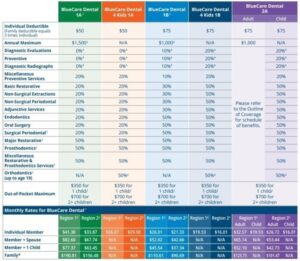
Affordable dental insurance plans can be a game changer for your oral health and your wallet. With so many options available, it’s easy to feel overwhelmed when trying to choose the right one. However, understanding the key features and comparing various plans can lead to significant savings and better coverage for your dental needs.
This guide will explore the essential aspects of affordable dental insurance, including how to evaluate plans based on their cost-effectiveness, the differences between dental and health insurance, and tips for selecting the best coverage tailored to your individual circumstances.
Understanding Affordable Dental Insurance Plans

Affordable dental insurance plans are designed to provide necessary dental care at a lower cost, making it accessible for individuals and families without breaking the bank. These plans typically cover preventive services like cleanings and check-ups, as well as basic restorative procedures. Understanding the features of these plans can help you make informed decisions about your dental care.The key features that define affordable dental insurance plans include monthly premiums, deductibles, co-pays, and coverage limits.
Monthly premiums are the costs you pay for the insurance, while deductibles are the amounts you must pay out-of-pocket before the insurance kicks in. Co-pays are fixed fees for specific services, and coverage limits determine how much the plan will pay for different treatments. Knowing these factors is essential for evaluating the overall cost-effectiveness of each plan.
Evaluating Cost-Effectiveness of Dental Insurance Plans
When assessing the cost-effectiveness of dental insurance plans, consider the following aspects to ensure you select the most suitable option for your needs:
Coverage Scope
Look closely at what services are covered. Preventive care is often fully covered, while major services might only be partially covered.
Premium Costs vs. Expected Use
Calculate how much you will pay annually in premiums compared to how much dental care you anticipate needing. This helps determine if a plan is worth it.
In-Network vs. Out-of-Network Providers
Being aware of which dentists are in-network can help you save more. In-network providers typically offer services at reduced rates.
Annual Maximums
Pay attention to the maximum amount the insurance will pay for dental services in a year. It’s crucial to ensure it aligns with your expected dental expenses.
Exclusions and Limitations
Each plan has its exclusions. Understanding these can prevent unexpected out-of-pocket costs later.Understanding these factors is vital in determining the best value for your dental insurance investment.
Importance of Coverage Limits and Waiting Periods
Coverage limits and waiting periods play significant roles in determining the effectiveness of a dental insurance plan. Coverage limits refer to the maximum amount an insurance plan will pay for dental services within a policy year. For example, if your plan has a limit of $1,500, any expenses beyond this amount will be your responsibility. Waiting periods are another critical component.
Many dental insurance plans impose a waiting period before covering certain services, particularly major treatments such as crowns or bridges. This means that even if you have insurance, you may have to wait several months before you can access full benefits for those procedures.Understanding these elements helps to manage expectations regarding potential out-of-pocket expenses and ensures that the selected plan aligns with your anticipated dental needs.
Comparison with Other Insurance Types

Understanding the distinctions between dental insurance and other types of insurance is crucial for making informed decisions. Each type of insurance serves different purposes and covers various aspects of health and property, influencing their costs and coverage details. This comparison will focus on dental insurance alongside health insurance, disability insurance, and flood insurance, highlighting their differences and interdependencies.
Differences Between Dental Insurance and Health Insurance
Dental insurance and health insurance differ significantly in terms of coverage and costs. While health insurance provides a broad range of medical services covering various health needs, dental insurance typically focuses solely on oral health. Here are the key differences:
- Coverage Scope: Health insurance includes services like hospital visits, surgeries, and preventive care, whereas dental insurance primarily covers routine check-ups, cleanings, and specific procedures like fillings or extractions.
- Cost Structures: Dental insurance usually has lower premiums and deductibles compared to health insurance. For instance, a typical dental plan might cost around $20-$50 per month, while health insurance premiums can exceed $300 monthly based on coverage levels.
- Waiting Periods: Dental policies often have waiting periods for major procedures, while health insurance generally provides immediate access to covered services after enrollment.
Complementary Role of Disability Insurance
Disability insurance can significantly enhance one’s overall wellbeing when paired with dental insurance. While dental insurance addresses oral health needs, disability insurance provides financial support in the event of an inability to work due to illness or injury. The interplay between these two types of insurance can offer a more comprehensive safety net.
“Disability insurance ensures that you can afford essential health services, including dental care, without the stress of lost income.”
Having both insurances means that if an individual faces a disability, they can maintain their dental care routine, which is vital for overall health. For instance, someone recovering from surgery might rely on disability insurance for income while using dental insurance to manage ongoing oral treatments.
Benefits of Dental Insurance vs. Flood Insurance
When considering necessities and risks, dental insurance and flood insurance serve distinct purposes. Dental insurance is essential for maintaining oral health through preventive care, while flood insurance protects against property damage from flooding. Here are some important comparisons:
- Necessity: Dental insurance is often seen as a necessity for individuals who prioritize oral health, whereas flood insurance may be deemed necessary based on geographic location and risk assessments.
- Risk Management: Dental insurance mitigates health risks associated with neglecting oral hygiene, while flood insurance addresses property risks from natural disasters.
- Financial Impact: The cost of untreated dental issues can lead to expensive medical bills, while flood damages can result in significant property loss, both necessitating different types of coverage for financial security.
Both insurances play essential roles in protecting individuals, albeit in different realms – health and property. Understanding these differences enables better financial planning and risk management strategies to ensure adequate protection in various aspects of life.
Selecting the Right Plan
When it comes to dental insurance, selecting the right plan can greatly influence your overall dental health and financial savings. With numerous options available, making an informed choice is essential to ensure you receive the best care while staying within your budget. This section Artikels key considerations and provides a structured approach to help you navigate the selection process effectively.
Essential Questions to Ask When Choosing a Dental Insurance Plan
Before finalizing a dental insurance plan, asking the right questions can clarify coverage and help you avoid unexpected costs. Here is a list of essential questions to consider:
- What types of services are covered under the plan?
- Is there a waiting period for certain procedures?
- What is the maximum annual benefit limit?
- Are pre-existing conditions covered?
- What is the deductible, and how does it apply to different services?
- What is the co-payment or coinsurance percentage for various treatments?
- Which dentists are included in the network, and what happens if I see an out-of-network provider?
- Are there any exclusions or limitations on coverage?
Step-by-Step Guide for Comparing Multiple Dental Plans
To ensure you choose the best dental insurance plan, follow this structured approach to compare options effectively:
- Gather Information: Obtain brochures or online details for each dental insurance plan you are considering.
- Create a Comparison Chart: Compile a chart that includes key features such as coverage limits, deductibles, premiums, and waiting periods.
- Evaluate Network Dentists: Check which dentists participate in each plan’s network and their reputation for quality care.
- Assess Coverage Levels: Compare the types of services covered, including preventive, basic, and major procedures.
- Analyze Costs: Calculate total potential costs by considering premiums, deductibles, and out-of-pocket expenses based on your expected usage.
- Read Reviews: Look for reviews or testimonials from current or past policyholders regarding satisfaction and claims experience.
- Make an Informed Decision: Use your findings to choose the plan that best meets your financial and dental care needs.
Calculating Potential Savings with Different Plans
Understanding potential savings can help you evaluate the financial benefits of various dental insurance plans. Here’s a step-by-step example of how to calculate potential savings:
1. Assume you have two dental insurance plans to compare
Plan A and Plan B.
For both plans, determine the following:
Annual Premium
Plan A
$300
Plan B
$400
Maximum Annual Benefit
Plan A
$1,500
Plan B
$2,000
Average Out-of-Pocket Costs for Common Procedures
Plan A
$200
Plan B
$150
3. Calculate the total annual costs (premium + average out-of-pocket)
Plan A
$300 + $200 = $500
Plan B
$400 + $150 = $550
4. Assess the potential savings by comparing maximum benefits
If you utilize your maximum benefit in each plan, you would save
Plan A
$1,500 – $500 = $1,000 savings
Plan B
$2,000 – $550 = $1,450 savingsBy analyzing these factors, you can determine which plan offers better value based on your dental health needs.
Ending Remarks
In summary, finding the right affordable dental insurance plan doesn’t have to be a daunting task. By utilizing the tips and comparisons Artikeld above, you can make informed decisions that not only protect your dental health but also fit your budget. Remember, investing in dental insurance is an investment in your overall wellbeing, so take the time to choose wisely.
Expert Answers
What should I look for in an affordable dental insurance plan?
Look for coverage limits, waiting periods, and the types of services included, such as preventive care or major procedures.
How can I calculate potential savings with different dental plans?
Compare the premiums, deductibles, and out-of-pocket maximums, and consider your expected dental needs to estimate your costs.
Are there any specific questions I should ask when choosing a plan?
Yes, inquire about coverage specifics, network dentists, and any exclusions or limitations in the plan.
Can I keep my current dentist with a dental insurance plan?
This depends on the plan; some may require you to use in-network providers while others offer more flexibility.
How often should I review my dental insurance plan?
It’s a good idea to review your plan annually or when your dental needs change to ensure it still meets your requirements.







